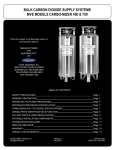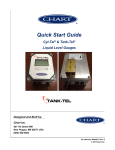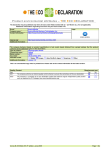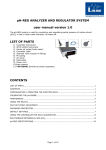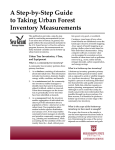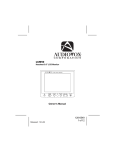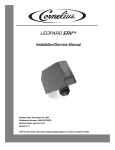Download Carbo-Max 750 HF
Transcript
Carbo-Max 750 HF User Manual wwww.chartbeverage.com b Copyright: Chart Industries, Inc., Jan. 2003 Table of Contents I Safety . . . . . . . . . . . . . . . . . . . . . . . . . . . . . . . . . . . . . . . . . . . . . . . . . . . . . . 1 Warnings First Aid and Emergency Action Further Information Sources II General Description . . . . . . . . . . . . . . . . . . . . . . . . . . . . . . . . . . . . . . . . . . 2 System Overview Installation Storage vessel Vessel Plumbing Fill Circuit Pressure Control Circuit Gas Use Circuit Safety Vent Circuit Pressure and Contents Gauges CO2 Fill Box Fill Hose and Vent Line Your Bulk CO2 Supplier III Parts Identification . . . . . . . . . . . . . . . . . . . . . . . . . . . . . . . . . . . . . . . . . . . 5 MVE Carbo-Max 750 Installation Components IV Vessel Specifications . . . . . . . . . . . . . . . . . . . . . . . . . . . . . . . . . . . . . . . . . 8 Dimensions Rates and Pressures Design Criteria V Operation And Troubleshooting . . . . . . . . . . . . . . . . . . . . . . . . . . . . . . . . 9 Facts to Know General Operating Instructions Troubleshooting Guide - CO2 Vessel Troubleshooting Guide - Fill Box VI Ordering Service And Parts . . . . . . . . . . . . . . . . . . . . . . . . . . . . . . . . . . . 14 Service and Maintenance Ordering Parts or Service Important Telephone Numbers VII Warranty . . . . . . . . . . . . . . . . . . . . . . . . . . . . . . . . . . . . . . . . . . . . . . . . . . . 15 Warranty Policy Warranty Claims Procedure VIII System Flow Schematic . . . . . . . . . . . . . . . . . . . . . . . . . . . . . . . . . . . . . . 16 Copyright: Chart Industries, Inc., Jan. 2003 c I Safety to work with CO2 and the bulk liquid CO2 pressure vessels. They should be familiar with all pertinent safety procedures. IMPORTANT SAFETY PRECAUTIONS The type of vessel described in this manual holds and dispenses carbon dioxide (CO2) gas under pressure. All persons using this equipment must read and understand the operation and safety information contained in this manual. FIRST AID AND EMERGENCY ACTION If inhaled: • Move to fresh air immediately. • If not breathing, give artificial respiration. • If breathing is difficult, give oxygen. • Get immediate medical attention. WARNINGS CO2 gas is a colorless, odorless, tasteless gas that displaces oxygen and will not support life. It is difficult to detect without special equipment. Avoid breathing or contacting CO2 in gas, liquid or solid form. Exposure to concentrations of less than 5% for less than 15 minutes can cause physical symptoms including unconsciousness, injuries or death. Even low concentrations of CO2 can cause: In case of frostbite: • End exposure immediately. • Do not rub or pour water on the affected area. • Get immediate medical attention. Rescue: • Do not attempt a rescue in areas of high CO2 concentrations without proper life-support or rescue equipment. (Avoid being the next victim.) • Thoroughly ventilate areas of possible high CO2 concentration before entering them. • Dizziness, headaches, nausea or disorientation • Increased respiration or heart rate • Shortness of breath or rapid suffocation. CO2 is heavier than air and can collect in low areas such as basements, stairwells, and confined spaces. Avoid entry into areas where CO2 leaks or high concentrations of CO2 are suspected. Enter those areas with caution only after they have been thoroughly ventilated. In case of spills or leaks: • Evacuate all personnel immediately from affected areas. • Thoroughly ventilate the area of the spill or leak before entering. • CO2 is heavier than air. It displaces oxygen and will collect in low or confined areas. Whenever the vessel is inside a building it’s safety relief circuit must be connected to an outdoor vent typically in the fill box. The fill box and/or vent must never be located in or above any belowground spaces or stairwells. The vessel must not block emergency exits, aisles, fire suppression equipment or utility boxes or accesses. CO2 lines or hoses must be located away from traffic areas and heat sources and must be protected from potential causes of damage. All connections, lines, and components must be leak-free . FOR MORE INFORMATION CONTACT: Local CO2 supplier or Compressed Gas Association 725 Jefferson Davis Highway, Suite 1004 Arlington, VA 22202-4100 USA Telephone: (703) 412-0900 FAX: (703) 412-0900 This equipment should be installed and serviced only by professional personnel who are qualified 1 Copyright: Chart Industries, Inc., Jan. 2003 II General Description UID E LIQ DIOXID BON CAR special insulation. The vacuum and insulation minimize the entry of unwanted heat into the liquid CO2 stored in the inner vessel. When CO2 gas is needed, liquid CO2 is withdrawn from the inner vessel, converted to gas and dispensed to the beverage system or other use point. System Overview The MVE Carbo-Max 750 ‘High Flow’ bulk carbon dioxide (CO2) system is designed for low pressure storage and supply of carbon dioxide gas for beverage carbonation, brewing, beer dispensing, ph control in swimming pools, and other purposes. The system consists of three primary elements: the CO2 storage vessel, CO2 fill box, and the fill and vent hoses. Vessel Plumbing Plumbing components on the Carbo-Max 750 vessel perform six functions: Installation • • • • • • The Carbo-Max 750 can only be operated as a stationary system. The system is comprised of the permanently installed vessel, an outdoor-mounted CO2 fill box, and the connecting fill and vent hoses. The fill hose and vent line join the vessel to the outdoor fill box. The fill box allows the CO2 supplier to fill the vessel from outside the building. The delivery process takes only about 10-15 minutes and does not interrupt the CO2 user’s operations. Note: The Carbo-Max 750 bulk CO2 storage vessel is not DOT regulated and must not be transported when it contains liquid CO2. Fill Circuit The fill circuit allows liquid CO2 to be transferred into the vessel during the delivery process. It consists of a brass fill fitting in the fill box, a fill hose, a valve on the vessel, and MVE’s patented Sure-Fill assembly. Liquid CO2 is transferred into the vessel through the brass fill box fitting and the fill hose. The shut-off valve on the vessel’s fill port allows service to be performed on the fill-box / fill-line segment of the fill circuit without emptying the vessel. Storage Vessel The vessel component in a Carbo-Max 750 CO2 storage system consists of an inner vessel and an outer vessel, much like a ThermosTM bottle. The space between the two vessels contains a nearly perfect vacuum and a Copyright: Chart Industries, Inc., Jan. 2003 Liquid CO2 fill Gas supply (Gas Use) Liquid supply (Liquid Use) Pressure control (Economizer) Safety vent or pressure relief (Sure-Fill & Vent) Pressure and contents measurement (Gauges) 2 The vessel’s Sure-Fill assembly enables fast, troublefree filling without having to manually vent excess pressure that might develop during a CO2 delivery. The Sure-Fill automatically maintains the optimum internal vessel pressure during the fill process by venting excess pressure outdoors through the safety vent and fill box. This vent process stops when the vessel is full. Fill Circuit Sure-FillTM Circuit Economizer Circuit Vent Circuit Gas Delivery Circuit Liquid CO2 Dispense Port 1/2 E Gas Use Circuit Carbon dioxide gas is supplied to the use point through the gas use circuit. The Carbo-Max 750 withdraws liquid CO2 from the bottom of the inner vessel through a vaporizer coil where it converts to gas for final line use. F LIQUID GAS The conversion from liquid to gas occurs when liquid CO2 flows through a stainless steel vaporizer/gas use coil located between the inner and outer vessel walls. As it is needed, carbon dioxide gas is produced by the vaporizer coil. Then it passes through the isolation valve and final line regulator to the point of use. The final line regulator controls gas flow to the use-point. The factory setting on the final line regulator is 90 psi but the pressure may be adjusted to the needs of the application. The regulator setting for soft drinks is commonly between 90 and 115 psi. Secondary pressure regulators may be added ‘downstream’ for applications such as bag-in-the-box, beer, or diet systems. Consult with the use-point equipment manufacturer for the proper regulator and pressure setting. Liquid Supply Port The Carbo-Max 750 is equipped with an alternative liquid CO2 supply port. This port should be used only for high demand applications that require CO2 to be dispensed in liquid form. The vessel’s gas supply and liquid supply ports may be used simultaneously for separate applications. Pressure Control Circuit The pressure control circuit (also called the economizer circuit) assists in regulating the operating pressure of the vessel. It maintains the correct operating pressure while it conserves gas for efficient system performance. Vaporizer Coil 6” (15.2 cm) Uni-body Legs Sufficient internal vessel pressure is needed for supplying CO2 gas and for preventing the stored liquid 3 Copyright: Chart Industries, Inc., Jan. 2003 point to fill the storage vessel and to vent excess vessel pressure out of the building. The fill box has a brass fill fitting, a connection for the safety relief vent circuit, a connection point for a safety clip, and a lockable door. Two standard types of fill boxes are available; a surface-mount model and a flush-mount model. Fill boxes must be mounted outside the building where they are easily accessible to the CO2 supplier and where they can safely disperse excess CO2 pressure outdoors. carbon dioxide from changing to ‘dry ice,’ the solid form of CO2. However, internal pressure that is too high can cause venting and difficulties refilling the vessel. The “economizing” process is controlled by a regulator that monitors the vessel’s internal pressure. When the vessel pressure exceeds the set point of the regulator (factory set at 140 psi), the regulator opens allowing CO2 gas to flow directly into the gas use circuit whenever CO2 gas is being used. By taking gas from the top of the vessel instead of liquid CO2 from the bottom, the internal pressure of the tank is reduced and controlled. Fill Hose And Vent Line The third major element of a stationary bulk CO2 system is comprised of a fill hose and vent line. These two lines join the CO2 storage vessel with the outdoor fill box. Safety Vent Circuit The inner pressure vessel of this storage system is designed to meet or exceed the ASME Section VIII, Division 1 pressure vessel code. The code dictates that the vessel be protected against excess pressure by a safety relief valve. Chart uses two safety relief valves for added safety; an ASME relief valve set at 300 psig and an additional relief valve set at 450 psig. The relief valves must always be vented outdoors by a vent tube, usually through the fill box, to prevent potential concentration of CO2 within the building. The 300 psig relief valve may open during CO2 deliveries or when CO2 is not being used regularly. The fill hose is a pressure rated line that connects the brass fill fitting in the fill box to the fill circuit on the vessel. It is constructed with FDA compliant materials, The vent line is as important as any component in the system. It connects the safety relief valves on the vessel to either the outdoor fill box or to an alternative outdoor vent tube. NOTE: The Carbo-Max 750 must always be connected to an outdoor vent line when it contains CO2 and is indoors. Pressure And Contents Gauges A contents and pressure gauge indicate the status of the CO2 inside the vessel. The vessel pressure gauge measures the pressure in the top space of the inner vessel. This pressure can normally range between 125 psig and 300 psig but the typical vessel operating pressure is 125 to 150 psig. The Bulk CO2 Supplier The bulk CO2 supplier is also an important part of the system. Most CO2 suppliers not only provide timely delivery of CO2 but also install and service the system. For service, parts, information, emergency CO2 delivery, or other CO2 related assistance, contact the local Chart authorized CO2 supplier. A place has been designated on page 14 of this manual to record the name and phone number of the CO2 supplier and other important service contacts. The vessel contents gauge measures the approximate level of CO2 liquid in the vessel. The movement of a magnetic rod “floating” in the liquid CO2 causes the needle on the contents gauge to move as the level of liquid CO2 in the vessel changes. NOTE: Because the float-rod does not actually float on the surface of the liquid CO2 it does not provide a precise measurement of liquid CO2 level. CO2 Fill Box The stainless steel CO2 fill box is the second major element of the Carbo-Max 750 CO2 storage system. The purpose of the fill box is to provide a convenient Copyright: Chart Industries, Inc., Jan. 2003 4 III Parts Identification Carbo-Max 750 (High Flow) Plumbing Components 51 22 21 80 33c 83 20 61 43 19 33d 18 48 51 48 17 45 46 57 42 44 52 32 60 31 52 33b 47 30 79 25 49 39 60 40 33a 34 41 35 5 Copyright: Chart Industries, Inc., Jan. 2003 III Parts Identification Continued Carbo-Max 750 (High Flow) Plumbing Components ITEM 17 18 19 20 21 22 25 30 31 32 33a 33b 33c 33d 34 35 39 40 41 42 43 44 45 46 47 48 49 51 52 57 60 61 79 80 83 94 95 - PART NO. 9094119 5411622 5411029 2300244 5411612 10601088 10591369 1212962 11082128 11708451 11708400 1716162 1716162 1716162 1716162 1717579 1211102 1812289 1213092 2015179 1210622 2111312 11673631 11762975 11762983 1210482 11708442 11044869 6910623 1611592 1110112 1013042 5503831 11720484 10654315 1812279 3911217 3911016 11789983 3836609 10784072 11784496 10591140 DESCRIPTION QTY FUNCTION Float Rod Assembly with Magnet 1 Indicates liquid CO2 level in the vessel Spring Retainer 1 Secures spring to float rod for adjustment Extension Spring 1 Provides tension on float rod O-Ring, Liquid Level Gauge 1 Seals brass plug to vessel Plug, Brass, Liquid Level Gauge (3/4”-16) 1 Secures the contents gauge to the vessel Liquid Level Gauge Assembly 1 Includes items 17, 18, 19, and 21 Gauge, Liquid Level / Contents (Roto-Cal) 1 Indicates approximate liquid CO2 contents Brass Plug (1/8” MPT) (not pictured) 1 Seals unused port on Economizer regulator Ball Valve (3/8” FPT) 1 Isolates CO2 fill hose from vessel. Relief Valve, 450 psig (1/2” MPT) 1 Secondary inner vessel safety relief valve Relief Valve, 300 psig (1/2” MPT) 1 Primary inner vessel safety relief valve Ball Valve (1/4” MPT x 1/4” FPT) 1 Isolates liquid-side of Economizer regulator Ball Valve (1/4” MPT x 1/4” FPT) 1 Isolates gas-side of Economizer regulator Ball Valve (1/4” MPT x 1/4” FPT) 1 On / off control for gas supply Ball Valve (1/4” MPT x 1/4” FPT) 1 Opens / closes sure-Fill circuit Ball Valve, Brass (1/4” NPT) 1 On / off control for liquid CO2 supply Plug, Brass (1/4” MPT) 1 Seals liquid CO2 port when not in use Regulator, Economizer, 140 psi (1/4” FPT) 1 Controls vessel pressure Tee, Brass (1/4” FPT x 1/4” FPT x 1/4” MPT) 1 Joins Economizer circuit components Pressure Gauge, 0-400 psi (1/4” MPT CBM) 1 Displays internal vessel pressure Tee, Brass (1/4” FPT) 1 Connects gas use and economizer circuits Regulator, Final Line, 90 psi (1/4” FPT) 1 Controls CO2 gas pressure to use-point Pressure Gauge, 0-160 psi (1/8” MPT CBM) 1 Indicates CO2 gas pressure to use-point Tube Stub, Brass (1/4” MPT x 1/2” ODT) 1 Gas use line plumbing extension Connector, Brass (1/4” x 1/2” ODT) 1 Connects final line regulator to gas use circuit Elbow, Street, Brass 90D (3/8” MPT) 1 Connects 450 psi relief valve to vent circuit Tee, Brass Run, (1/2” ODT x 3/8” MPT) 2 Joins vent circuit components Branch Tee, (1/2” FPT) 1 Manifolds primary & secondary relief valves Tube, Soft Copper Type L (½” OD, Nominal .375”) ft Joins vent circuit components Adapter, Pipe-Away (3/8” FPT) 2 Joins 450 & 350 psig relief valves to vent fittings Connector (5/8” ODT x 3/8” MPT- 45o Flare) 1 Connects CO2 fill hose to vessel Elbow, Brass 90D (5/16” ODT x 1/4” MPT) 2 Joins Economizer line and circuit components Tubing, Stainless (5/16” OD) 1 Economizer line Sure-Fill™ Tube Assembly (3/4”-16) 1 Controls CO2 filling and pressure venting Elbow, Brass, 90D (1/2” ODT x1/4” MPT) 1 Joins Sure-Fill assembly to vent circuit Regulator, Sure-Fill, 200 psi (1/4” FPT) 1 Vents excess pressure during CO2 filling Cap, Plastic, Black 1 Covers vacuum pump-out port Cap, Plastic, Blue 1 Covers vacuum regeneration port Label, Carbo-Max 750 High Flow 1 Denotes vessel model 1 Describes vessel safety and operations Label, CO2 Operations Label, Chart Industries, Inc. 1 Identifies vessel manufacturer Label Only, Caution Carbon Dioxide 1 Included in label kits 1 Identifies vessel’s contents CO2 Regulation Label UN 2187 Copyright: Chart Industries, Inc., Jan. 2003 6 III Parts Identification Continued Stationary Installation Components Surface-Mount Fill Box Part No. 9722279 Flush-Mount Fill Box Part No. 9723139 5 1 4 2 6 2 ITEM PART NO. 3 1 DESCRIPTION QTY. FUNCTION 1 11381021 CO2 Fill Fitting, Brass 1 Connection for CO2 delivery vessel hose 2 3 4 5 6 7 4310689 4310959 2914071 11386771 9111289 10503517 1111182 Lock Assembly (includes key) Key for Lock Assembly (not pictured) Locknut SS w/nyl Insert Surface-Mount CO2 Fill Box (without fittings) Flush-Mount CO2 Fill Box (without fittings) Flush-Mount Fill Box Plate Connector (3/4” MPT x 5/8” - 450 Flare) 1 4 1 1 1 1 Locks fill box door Replacement key for fill box Attach fill fitting to fill box studs Allows outdoor filling and venting of vessel Allows outdoor filling and venting of vessel Holds brass fill fitting Connects fill hose to fill fitting 8 10802912 CO2 Fill Hose only, 5 ft. (2000 psi & FDA) 1 Transfers liquid CO2 from fill box into vessel 8 8 8 8 8 9 10802921 10802947 10802939 10370710 10370728 2811726 CO2 Fill Hose only, 10 ft. (2000 psi & FDA) CO2 Fill Hose only, 15 ft. (2000 psi & FDA) CO2 Fill Hose only, 25 ft. (2000 psi & FDA) CO2 Fill Hose only, 30 ft. (2000 psi & FDA) CO2 Fill Hose only, 50 ft. (2000 psi & FDA) Vent Hose (lengths match fill hose) 1 1 1 1 1 1 Transfers liquid CO2 from fill box into vessel Transfers liquid CO2 from fill box into vessel Transfers liquid CO2 from fill box into vessel Transfers liquid CO2 from fill box into vessel Transfers liquid CO2 from fill box into vessel Vents excess vessel pressure outdoors Fill and Vent Hose Kits PART NO. 10973252 10973308 10973324 DESCRIPTION 5 ft Fill & Vent Hose 10 ft Fill & Vent Hose 15 ft Fill & Vent Hose PART NO. 10973332 10973341 10973359 7 DESCRIPTION 25 ft Fill & Vent Hose 30 ft Fill & Vent Hose 50 ft Fill & Vent Hose Copyright: Chart Industries, Inc., Jan. 2003 IV Vessel Specifications Carbo-Max 750 HF Dimensions Diameter 26 in (66 cm) Height w/o legs (w/legs, add 5 1/2 inches) 68 in (173 cm) Empty Weight 430 lb (195 kg) Full Weight 1201 lb (545 kg) Net Volume 82 gal (310 liters) Storage Capacity (CO2 saturated @125 psig [8.6 bar g] ) 771 lb (350 kg) Gas Use Connection 1/4” Fill Line Connection 5/8” Male 450 Flare Vent Line Connection 1/2” OD Tubing Rates and Pressures CO2 Gas Delivery Rate / Continuous 15 lb/hr ( 6.8 kg/hr) (approximately 840 - 16 oz. drinks / hr.) Liquid CO2 Delivery On demand Evaporation Rate (No loss in normal applications) 3.0 lb/day (1.4 kg/day) Max. Allowable Working Pressure (MAWP) 300 psig (20.7 bar g) ASME Relief Valve Setting 300 psig (20.7 bar g) Additional Relief Valve Setting 450 psig (31.0 bar g) Sure-Fill Regulator Setting 200 psig (13.8 bar g) Design Criteria Design Specifications ASME Section VIII, Division 1 Design Specifications Meets with US and Canadian approvals Fill System Single Line, pressure differential Patented Sure-Fill System Standard Insulation Type Vacuum with Super Insulation Pressure Control Economizer Circuit Liquid Level Gauge Float Type: Magnetic ‘Roto-Cal’ Outer Vessel Material Stainless Steel Inner Vessel Material Stainless Steel Floor mount Design (Meets NSF standards) Optional Permanent Legs Copyright: Chart Industries, Inc., Jan. 2003 8 V Operation and Troubleshooting Facts To Know General Operating Instructions 1. A vessel’s normal internal operating pressure (41) is between 125 psi and 150 psi. 1. Always use caution when working with CO2. Read and understand the “Safety” section of this manual. 2. Vessel pressure can be as high as 300 psi after a delivery, but returns to its normal operating pressure after a day or two of normal CO2 use. 2. The Carbo-Max 750 system does not require adjustment under normal operating conditions. 3. The gas supply pressure (44) is normally between 90 psi and 120 psi. 3. Check the vessel daily before using CO2. See ‘fact to know’ number 10. 4. Frost or condensation on the vessel is normal during periods of CO2 use. 4. In an emergency the flow of CO2 from or through the Carbo-Max 750 can be stopped by closing the following valves: 5. Frost or condensation on the vessel before starting the daily use of CO2 is a sign of a CO2 leak. Have the leak fixed. 6. A Carbo-Max 750 HF holds about 750 lbs of CO2 to meet use demands of 50 - 300 lbs of CO2 per week. 7. The contents gauge (22) displays the approximate amount of liquid CO2 in the vessel. 8. CO2 becomes dry ice below a pressure of 61 psi. Stop using CO2 from the vessel if its pressure (41) reaches 70 psi or less. 9. An isolation (shut-off) valve is open when its handle is parallel to the valve body and the line. The valve is closed when its handle is perpendicular to the valve body and the line. • Valve 33c to stop the flow of gas from the vessel to the beverage system or other use-point. • Valve 30 to stop CO2 flow or leakage through the fill hose and/or the brass fill fitting in the outdoor fill box. • Valve 33a to stop CO2 flow through the Economizer circuit. Closing valve 33c will also stop CO2 flow through the Economizer circuit but will also stop the flow of CO2 gas to the end use point. • Valve 34 controls the flow of liquid CO2. Be sure valve 34 is closed while removing plug 35 for liquid CO2 service. 5. For CO2 equipment issues, call your CO2 supplier or service specialist. Before calling for service or trouble shooting assistance, please have the following information at hand: 10. Every day before starting operations and CO2 use check for: • CO2 leaks (See “Safety”.) • Pressure readings (41 and 44) • CO2 contents (22) • Abnormal frost or condensation • Anything unusual. 9 • Serial number of the vessel • Description of the problem • Readings from: the vessel contents gauge (22), the vessel pressure gauge (41) and the final line pressure gauge (44). • Observations such as unusual frosting and/ or events related to the problem. Copyright: Chart Industries, Inc., Jan. 2003 V Operation and Troubleshooting CO2 Storage Vessel INDICATION No CO2 to carbonator or other use-point POSSIBLE CAUSE CORRECTIVE ACTION 1. Switch to emergency CO2 gas cylinder. CO2 storage vessel is empty. 2. Call CO2 supplier for delivery. . OR Carbonated drinks are “flat.” Frost on the bottom or sides or top of the vessel. Isolation valve (33b) to final line regulator is closed. Open valve or valves as needed. Gas supply Isolation valve (33c) is closed. Vessel pressure (41) is low (110 psi or less). Check for leak in gas supply lines, beverage system, vessel plumbing, vessel safety system and/or fill box. (Frost should not be present on vessel after extended periods with no CO2 use.) Economizer regulator (39) is not operating properly; set too low or stuck open. Close isolation valve (33c) and switch to emergency CO2 gas cylinder. If tank pressure fails to rise, see section on low vessel pressure. Unknown Call CO2 service agent. A normal condition during or following CO2 use. None. Check vessel for frost / leaks each morning before starting CO2 use. Leak in beverage system and/or gas supply lines or CO2 fill box. (When frost is present after extended periods of no CO2 use.) 1. See “Safety.” Evacuate & ventilate room. Check for frost in the morning before CO2 has been used. If possible, locate and correct leak. 2. Call appropriate equipment service agent. Frost on vessel after extended periods with no CO2 use (such as in the morning before store operations begin. CO2 leak from the beverage system, vessel’s plumbing, or CO2 fill box. (Frost present after extended periods with no intentional CO2 use.) Constant low vessel pressure. [(41) below 125 psi] Economizer regulator (39) set low or stuck open. 1. See “Safety”. Evacuate & ventilate the room. 2. Call appropriate service agent. Call CO2 service agent. CO2 leak from vessel plumbing, CO2 fill box and/or vessel safety system 1. See “Safety”. Evacuate & ventilate the room. Sure-Fill assembly leaking or malfunctioning 1. Close Sure-Fill isolation valve (33d) to stop flow. Copyright: Chart Industries, Inc., Jan. 2003 2. Call CO2 service agent. 2. Call CO2 service agent. 10 V Operation and Troubleshooting CO2 Storage Vessel INDICATION Constant high vessel pressure. [(41) above 200 psi] High CO2 consumption. POSSIBLE CAUSE CORRECTIVE ACTION Normal condition for a few days following a CO2 delivery. None Normal when little or no CO2 is used. None Economizer regulator (39) set too high. Call CO2 service agent. Vessel has a weak vacuum. Call CO2 service agent. Increased beverage sales or CO2 use. None Vessel pressure (41) constantly high. See section on ‘vessel pressure too high’. CO2 leak from vessel plumbing, CO2 fill box, gas lines, and/or beverage or other use-point equipment. CO2 vessel will not fill. 1. See “Safety”. Evacuate & ventilate room. 2. Locate & correct leak if possible 3. Call appropriate service agent. Error in CO2 supplier invoice. Check CO2 usage history / pattern against supplier invoices. Consult CO2 supplier. CO2 vessel is already full. None Fill valve (30) is shut off or is faulty. Consult CO2 service agent. Brass fill fitting in CO2 fill box and/or on truck’s delivery hose is faulty. 1. Consult with CO2 supplier or service agent. 2. Have brass fill fitting(s) replaced if needed. Differential between store vessel pressure and delivery pressure is too small. (At start of fill, store vessel pressure should be 110 - 150 psi and delivery vessel pressure should be 275 - 300 psi). 1. Verify delivery vessel pressure is at least 275 psi and store vessel pressure (41) is between 110 and 150 psi. 2. Vent store vessel to lower pressure if needed. Note: Never vent vessel pressure to lower than 110 psi. Sure Fill™ assembly not operating (relieving) properly 1. Ensure that Sure-Fill valve 32d is open. 2. Consult CO2 service agent. Leak in Sure Fill™ assembly / regulator. (Pressure above check ball is lower than vessel pressure.) 1. Close Sure-Fill valve 33d for several minutes allowing pressure above check ball to equalize and ball to fall into the open position. 2. Contact CO2 supplier. Delivery vessel is empty. Consult supplier. Arrange for another delivery. Delivery vessel empty or truck delivery hose is obstructed, e.g. vehicle stopped on hose or hose is bent. Ask driver to make another delivery or clear obstruction or wait until obstruction clears. 11 Copyright: Chart Industries, Inc., Jan. 2003 V Operation and Troubleshooting CO2 Storage Vessel INDICATION Hissing sounds or evidence of gas leak. POSSIBLE CAUSE CORRECTIVE ACTION Normal for short periods of time from some regulators and relief valves. Large leaks from elsewhere in the system, sustained leaks, or frequent leaks are not normal. Observe leak, if it is not large and does not last long and occur frequently, no action is needed. 1. See “Safety”. 2. Evacuate all personnel from affected areas. 3. Ventilate the area. 4. Call CO2 service agent. Final line / gas use pressure gauge (44) indicates less than 90 psi. Final line regulator (43) intentionally set lower by beverage service agent. None Final line regulator (43) not operating in proper pressure range. Call CO2 service agent. Final line pressure gauge (44) damaged or faulty. Call CO2 service agent. One or more of the causes listed in “no CO2” or “flat drinks” problem section. 1. See indication sections regarding “no CO2”, “flat drinks” etc. 2. Call CO2 service agent. Copyright: Chart Industries, Inc., Jan. 2003 12 V Operation and Troubleshooting Fill Box INDICATION Fill box door will not close, lock, or open. POSSIBLE CAUSE CORRECTIVE ACTION Lock dirty or damaged. 1. Check for obstruction 2. Clean and oil lock 3. Replace lock if necessary Brass fill fitting in fill box leaking or hissing. 1. If driver is still on site, reconnect CO2 delivery hose and then disconnect. Particle of ice or debris caught in fill fitting poppet. 2. If driver is not available, carefully press poppet with dull instrument to re-seat poppet. 3. If leak continues after line warms, close the fill isolation valve (30) and call service agent. Threads on brass fill fitting are worn or stripped. CO2 is venting from fill box. Fitting is defective or sealing surface is worn due to normal wear. Close the fill isolation valve (30) on the vessel and call service agent to replace fitting. Normal wear. Fill fitting must be replaced. Contact CO2 service agent to replace fitting. Fill fitting cross threaded with the CO2 delivery hose coupler. Contact CO2 service agent to replace fitting. Normal during CO2 delivery. None Normal for short periods of time if vessel pressure is at or over 300 psi 1. NONE if for short period(s) of time Fill fitting is not sealing properly. Call CO2 service agent to replace fitting. 13 2. If vessel pressure consistently over 300 psi, see section on vessel pressure too high. Copyright: Chart Industries, Inc., Jan. 2003 VI Ordering Service and Parts Service and Maintenance the system at least once every two years. The check should be done to ensure safety and optimal system performance. 1. Service or maintenance work on the MVE bulk CO2 storage system should be performed only by Chart trained and authorized professional service agents who are familiar with CO2, bulk liquid CO2 pressure vessels, and all pertinent safety and service procedures. Chart recommends the use of Chart approved replacement parts. Contact Chart for the name of the authorized service agent(s) in your area. 4. The MVE bulk CO2 storage system has no user serviceable parts. An authorized professional service agent should perform all service work. NOTE: Any attempt by an unauthorized person to service or perform unauthorized modifications on the equipment will void the warranty. 2. Before calling for service or troubleshooting assistance, please have the following information at hand: • Serial number of the vessel • Description of the problem • Readings from: - the contents gauge (Item 22), - the vessel pressure gauge (Item 41) - the final line pressure gauge (Item 44). • Any special observations (for example, unusual frosting or events related to the problem) Ordering Parts Or Service For service contact your local authorized MVE CO2 supplier or equipment service agent. For parts contact your local authorized Chart service agent or order online directly from Chart at www.chartparts.com. Know the model and serial number of the vessel for which you are ordering parts. To assure that your order is processed promptly, list each item separately, being careful to specify the quantity, the part number, and the description of each item being ordered. 3. Chart recommends that a qualified professional service agent perform a thorough preventive maintenance check on Important Telephone Numbers Company Contact Person Phone Number CO2 Supplier __________________________ _________________ After-Hours / Emergency Number ________________ CO2 Service Agent __________________________ _________________ CO2 Equipment Installer __________________________ _________________ MVE Customer Service (612) 882-5000 or (800) 247-4446 [toll free in US] MVE Technical Service (612) 882-5000 or (800) 253-1769 [toll free in US] Copyright: Chart Industries, Inc., Jan. 2003 14 VI Warranty WARRANTY POLICY WARRANTY CLAIMS PROCEDURE Chart Industries, Inc. warrants to the Purchaser the Carbo-Max bulk CO2 system equipment for 90 (ninety) days from the Chart invoice date, that said equipment shall be free from any defects in workmanship and materials. Chart also warrants the reliability of the vacuum in the CO2 storage vessel for 5 (five) years from the date of the original Chart invoice. 1. All warranty claims must be previously authorized by: Chart Ind., Inc. Telephonic / electronic approval may be obtained by contacting Chart’s MVE Beverage Systems Technical / Customer Services at: • Telephone: 952-882-5000 800-253-1769 (Toll free in U.S.) • Facsimile: 952-882-5185 Purchaser agrees that as a pre-condition to any Chart liability hereunder, Purchaser or its appointed agents shall fully inspect all goods immediately upon delivery and shall give Chart written notice of any claim or purported defect within ten (10) days after discovery of such defect. or by writing to: Chart Industries, Inc. MVE Beverage System Technical Service 3505 County Road 42 West Burnsville, MN 55306-3803 USA As a further pre-condition to any Chart liability hereunder, an approved Chart service company must supply both parts replacement and labor. Chart may elect to repair or replace such equipment or any defective component or part thereof which proves to be defective, or to refund the purchase price paid by the original Purchaser. Chart shall not be liable for defects caused by the effects of normal wear and tear, erosion, corrosion, fire, explosion, misuse, or unauthorized modification. 2. Authorization must be obtained from Chart prior to shipping any equipment to Chart facilities. In order to process the return of a vessel its model and serial number must be provided. If approved, a Return Material Authorization (RMA) number will be provided. The RMA number must be prominently indicated on the packing slip and any packaging that accompanies the goods being returned. The customer returning the goods is responsible for all freight, proper packing, and any damage incurred during shipment of the goods back to Chart. Alterations or repair by others than those designated and approved by Chart or operation of such equipment in a manner inconsistent with Chart accepted practices and all operating instructions, unless pre-authorized in writing by Chart, shall void this Warranty. Chart’s sole and exclusive liability under this Warranty is to the Purchaser and shall not exceed the lesser of the cost of repair, cost of replacement, or refund of the net purchase price paid by the original Purchaser. Chart is not liable for any losses (including CO2), damages, or costs of delays, including incidental or consequential damages. Chart specifically makes no warranties or guarantees, expressed or implied, including the warranties of merchantability or fitness for a particular purpose or use, other than those warranties expressed herein. 15 Copyright: Chart Industries, Inc., Jan. 2003 VIII System Flow Schematic Economizer Isolation Valve Contents Gauge Sure-Fill Isolation Valve Liquid Supply Valve Sure-Fill Regulator Vessel Pressure Gauge R Gas Use Pressure Gauge VENT R PG Economizer Regulator RV-2 Safety Relief Valves PG LG Vessel Shut-Off Valve GAS RV-1 FILL R Final Line Regulator Fill Isolation Valve Gas Supply Valve Vaporizer Coil MVE Carbo-Max 750 HF CO2 System Copyright: Chart Industries, Inc., Jan. 2003 16 Chart Industries, Inc. Copyright © 2003 Chart Industries 3505 County Road 42 West Burnsville, MN 55306-3803 PART NUMBER 11789967 1/03 chartbeverage.com U.S. 800-247-4446 • Worldwide 952-882-5000 • Fax 952-882-5185 • www.chart-ind.com • e-mail: [email protected] 17 Copyright: Chart Industries, Inc., Jan. 2003




















